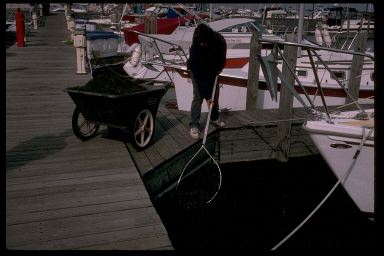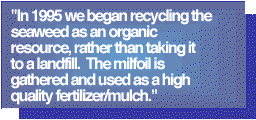
13. The Hammond Marina
Fertilizing Landscape With Seaweed Saves Money and Environment Environmental change
| Location: | 1111 Calumet Avenue, Hammond, Indiana 46320 |
| Telephone: | (219) 659-7678, fax: (219) 659-7679 |
| Interviewed: | Robert Nelson, Marina Director |
| Owned by: | Hammond Port Authority |
| Waterbody: | Cal River mouth, Lake Michigan |
Environmental change
The Hammond Marina reduced its chemical weed control by recycling nuisance seaweed into mulch and fertilizer for landscape plantings.
The second-largest public marina on Lake Michigan
The Hammond Marina is a publicly owned and operated home port marina on Lake Michigan, 14 miles southeast of Chicago and adjacent to the Cal River, which connects to the Mississippi River navigation system. The marina is protected by a double breakwater system that consists of a 14-foot above-water wall and a second submerged wall that minimize wave action. The marina basin contains 1,113 slips and 50 dry-storage spaces, launch ramps, and winter storage for boats. The marina has 12 full-time year-round employees and hires 40 more in the summer boating season, April through November. Bubbler systems protect the marina docks from winter ice.
Boat sizes range from 26 feet LOA to 80 feet LOA (average 33 feet), with 83% between 26 feet and 35 feet. Eighty percent are powerboats and 20% are sailboats. During the 1995 season, the slips were 70% occupied. On a busy summer weekend, 25% of the boats are used, with 15% occupied overnight. There are 10 liveaboards in the marina.
In addition to slips and land storage, the Hammond Marina offers transient dockage, three public fishing piers, a fuel dock, a retail store, pumpout, laundry, food/beverages, bike rentals, public restrooms, concierge service, a swim beach, and an aquatic resource center. Boats are launched and hauled with a hydraulic trailer.
Concessionaires in the marina provide boat charters, brokerage, a yacht club, and a restaurant/bar aboard the Milwaukee Clipper ship. Available boat maintenance services include fiberglass and hull repairs, engine repair, sail/rigging work, painting, electronic sales/service, welding, and bottom cleaning.
The marina was built in 1991 on an unused urban waterfront. The 54-acre complex was carved out of steel mill slag and shoreline created from dredged sand, which created a mile-long beach of pure sand. The Chicago boat harbors and one in Indiana are within 5 miles and serve a 3,000-boat population.
Management measures
The Hammond Marina complies with the marina management measure for habitat assessment, as well as the measures for marina flushing, water quality assessment, shoreline stabilization, storm water runoff control, fueling station design, sewage facility, maintenance of sewage facilities, solid waste, fish waste, liquid materials, petroleum control, boat cleaning, and public education.
Costs/benefits
In 1995, the Hammond Marina cut its annual $1,000 cost of disposing of milfoil seaweed to $200, while also gaining use of it as a mulch and fertilizer for the marina's gardens. That seaweed recycling program projects a saving of $17,500 for 1996 from a 50% reduction in chemical weed control.
Environmental improvements
The Hammond Marina, like many other freshwater facilities, is plagued with rapidly growing Asian milfoil seaweed. "This virulent plant causes damage to boat engines when it clogs the cooling water in-takes," said Marina Director Robert Nelson.
The weed grows to the water surface from roots on the bottom. It grows well when there is plenty of sunlight and nutrients available. Lake Michigan is significantly cleaner due to improved clean marina practices, city sewage treatment, reduced industrial waste, and filter-feeding zebra mussels. However, clearer water has resulted in better milfoil growth and an increased control problem for the marina. As the milfoil grows and is cut by boat propellers, the pieces float off and can take root somewhere else, worsening the problem.
Often during storms and after annual chemical treatment, the milfoil breaks off to form large floating mats, which drift around the marina getting trapped in slips. The milfoil is chemically treated with sonar pellets, which had cost the marina $35,000 including labor per season to apply. Cleaning the floating milfoil is a continuous task and in a typical year marina staff would remove 200 cubic yards of the weed, which had to be trucked away to the landfill.
"In 1995 we began recycling the seaweed as an organic resource, rather than taking it to a landfill. The milfoil is gathered and used as a high quality fertilizer/mulch on flower beds," said Nelson. "Additional quantities are used in local parks and by local landscape supply stores, which give it to customers. Gardeners now come to the marina for free bags of the seaweed."
"As a government facility, this saves the marina money and time tending to
ornamental flowers and trees. During the 10-week season, the weed-harvesting costs
are level, but the disposal costs had been up to $100 per week for an annual total
of $1,000. But it now costs us only $20 per week for workers to bag and mulch with
the weed, for a 1995 total cost of $200." With the 1995 harvesting success,
Nelson expects to halve the amount of weed-killing chemicals the marina used and
thus realize a 50% cost saving in 1996.
 |
| Harvesting Milfoil seaweed for recycling into landscape plantings. (photo by the Hammond Marina) |
"We use a special hook rake, invented by our staff, to harvest the seaweed. Boaters also help by placing the milfoil on the docks, where we pick it up."
The Hammond Marina takes pride in its beautiful park-like landscaping. "The public sees flower beds with amazing blooms," said Nelson. "In 1994 marina staff planted over 800 bulbs in the fall along the entranceway, near the main comfort station, the fish cleaning station, and other areas. Additional plantings are done for summer blooms."
Other improvements and benefits
"The Hammond Marina does all the right stuff: recycling of engine oil, aluminum, glass, and paper with recycling bins on the docks. We use the money from recycling for our disabled sailing program," Nelson said. The Hammond Adaptive Sailing Program teaches able and disabled persons how to sail and offers them an opportunity to socialize with people who share the same interest.
 Hammond constructed
a mini-beach adjacent to the marina on abandoned property, resulting in cleaning
of 2 acres of waterfront that had been a major source of refuse and flotsam and jetsam
litter. The cleanup cost the marina $2,000. Now the general public and boaters have
lake access and swimming beach use.
Hammond constructed
a mini-beach adjacent to the marina on abandoned property, resulting in cleaning
of 2 acres of waterfront that had been a major source of refuse and flotsam and jetsam
litter. The cleanup cost the marina $2,000. Now the general public and boaters have
lake access and swimming beach use.
Runoff from the parking lots is buffered with lawn edges. Shoreline erosion and internal waves are controlled with sloping riprap stone bulkheads.
"In addition to our pumpout station on the gas dock," Nelson wrote, "we added in 1994 a portable pumpout to take the service to boats in the slips. The portable cost $4,700, and had $1,500 in labor and parts. Boaters-especially on larger boats-have consistently complained about having to untie just to go to the gas dock for pumpouts. Additionally, and very importantly, when our main pumpout system is inoperative (such as for maintenance), the portable one is available. Between Memorial Day and Labor Day 1995, the portable earned $4,500 additional income primarily from slip holders in the marina. Many of them get pumped out even though their tank is only half full." Each pumpout costs $10 when done in the slip, but at the fuel dock the cost is $5.
One of the unique and highly successful environmental and educational initiatives at the Hammond Marina is a work-study program with a City of Gary social service agency. Called Pyramid, this summer program provides and pays 20 teenagers to help clean up the marina and beach at minimum wage. "The teens also do a good job mulching with the seaweed and weeding our gardens. Now our public areas are kept much cleaner on a 3-times-a-week basis. Customers appreciate the extra service on docks," said Nelson.
"This is a unique summer job program and is the only one I know of that is related to the harbor. A professor at Purdue University, who is an avid boater, runs the program. They target kids who could otherwise get into gangs. The teens get training in boating, boating safety, and boating economics. A future benefit may come as these teens contemplate boater success stories, and consider possible vocations in boating businesses," Nelson added. "This is an excellent source for additional boater services. I recommend that other marina managers check their local government and private foundations for similar help."
Marina director Robert Nelson has many years of prior experience as chief of all boating facilities in Chicago, and he has been active nationally in NASBLA and SOBA. His experience, enthusiasm, and innovation are serving the Hammond Marina very well. His motto is "Our service must exceed our customers' expectations." He added, "We look for employees who know how to treat people." And obviously how to run a clean marina, too.
http://www.epa.gov/owow/NPS/marinas/ch13.html
This page last updated October 4, 1999


